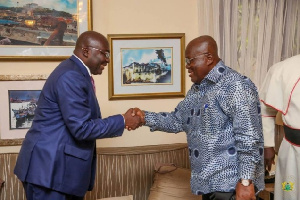Opinions of Monday, 19 June 2017
Columnist: Alhassan Musah
The inproportionate response of lending rates to monetary policy rate cut.
The Bank of Ghana’s Monetary Policy Rate (MPR) has been lowered by 350 basis points from 26% in January to 22.5%. This is the rate at which commercial banks borrow from the central bank on overnight basis (as a lender of last resort), to cover their short term liquidity/cash flow gaps.
The MPR also has a direct influence on the rate charged by commercial banks for lending to one another on overnight basis (this is known as interbank overnight rate). In fact there is a marginal difference between the MPR and the interbank overnight rate, ceteris paribus. Movements in overnight rate tends to closely follow the MPR.
As expected, there have been several calls by Ghanaians of all walks of life for commercial banks to reduce their lending rates in tandem with the recent reductions in the Bank of Ghana’s MPR as happens in some jurisdictions.
In Ghana, the minimum lending rates (base rates) of commercial banks are based on Bank of Ghana prescribed guidelines. These guidelines were developed in consultation with key stakeholders. The Bank of Ghana must indeed be commended for the transparency of these guidelines. There are several variables in the guidelines (market wide and bank specific ones) influencing the buildup of the rates. The bank specific factors include the banks’ operating costs, funding costs (interest on deposits and other borrowings) and expected return on equity (ROE). The market-wide variable is the 91-day Treasury bill rate. It should be noted however, that there are other constant variables in the guidelines.
One reason why commercial banks’ lending rates do not seem to move in proportion to the recent MPR reductions can be deduced from the factors listed above. One can see that the MPR only influences commercial banks’ lending rates through banks’ funding costs, to the extent that a commercial bank has utilized the bank of Ghana repo window during the period. Commercial banks that are able to manage their short term liquidity and rely less (or not at all) on borrowings from the central bank or from other commercial banks for a certain period, may not have their funding costs going up or down as the MPR does same. The funding costs may remain high if MPR comes down and customer deposit costs do not.
Additionally, even if the banks rely heavily on the Bank of Ghana MPR to fund their assets, it is important not to lose sight of the other variables. Banks invest heavily in running their businesses, infrastructure, technology, human resources etc. Unfortunately most of these are foreign currency denominated and are subject to inflation when the local currency depreciates against the exporting currencies, thus driving up operating costs.
The interplay of these factors largely determines the outcome of banks’ minimum lending rates in Ghana. Treasury bill rate or MPR may reduce or increase but other variable may not.
We are told that the Bank of Ghana, working with key stakeholders, may soon come out with revised guidelines on how commercial banks’ lending rate would be determined. This may establish a strong link between the monetary policy rate and banks’ lending rates if that is deemed to be workable in the Ghanaian banking system and meets the needs of majority of stakeholders.
By: Alhassan Musah
Treasurer, Stanbic Bank











